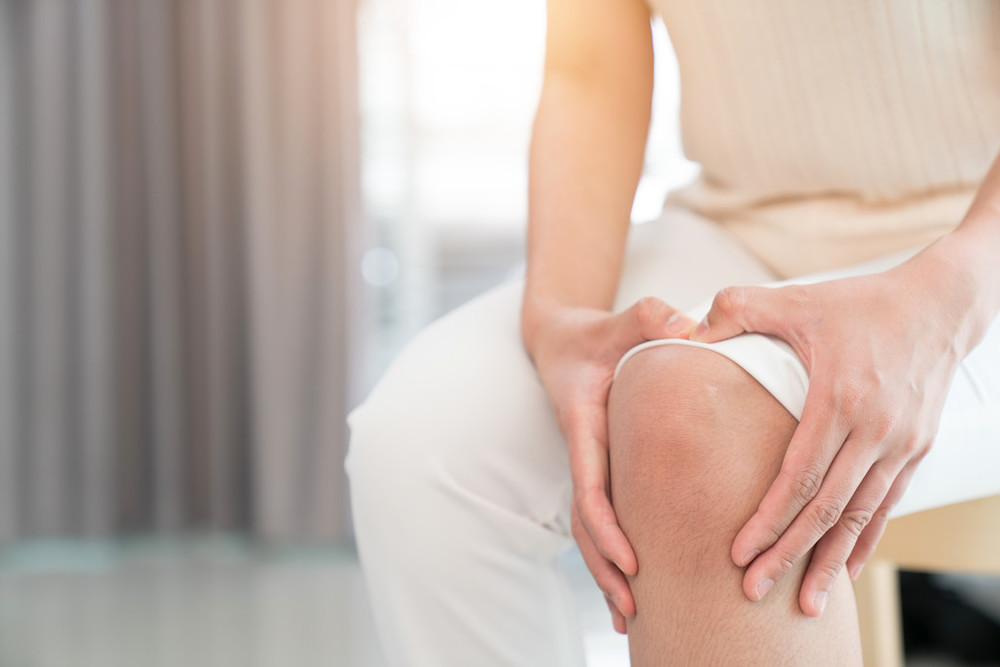





Today's Medicine
Arthritis Basics: Common Types, Symptoms and Treatment
Published: May 16, 2022

It’s estimated that over 22% of Americans have doctor-diagnosed arthritis, and as the U.S. population ages, that number is expected to grow. The Centers for Disease Control and Prevention (CDC) estimates that by 2040, 26% of adults in the U.S. will have arthritis.
The accompanying symptoms – often joint pain and stiffness – cause millions of people to miss work and limit their activities.
While we don’t know the causes of many types of arthritis, and there’s no known cure, we’re learning more about risk factors, treatment and management – all with the goal of helping people lead healthy, active lives.
Common Types of Arthritis
Arthritis is a broad term that encompasses over 100 conditions affecting joints, tissues surrounding joints and other connective tissues. Here’s a breakdown of some of the most common forms.
Osteoarthritis
Osteoarthritis is the most common type of arthritis and occurs in the hands, knees and hips when joint cartilage between the bones breaks down.
Symptoms
- Decreased range of motion
- Pain or aching
- Stiffness
- Swelling
Risk factors
- Age – Your risk increases over time.
- Family history
- Sex – Women are more likely to develop osteoarthritis.
- Joint injury or overuse
- Obesity – Excess weight can lead to more stress on joints and may have a metabolic link to osteoarthritis.
Meanwhile, researchers have found that some Asian populations have lower risks for osteoarthritis.
Diagnosis and Treatment
A primary care provider or rheumatologist – an arthritis specialist – can use a physical exam, X-rays and lab tests to diagnose osteoarthritis. Treatment may include:
- Assistive devices
- Medication
- Physical therapy
- Self-management strategies like weight loss and regular physical activity
- Surgery, if other treatments are ineffective

Rheumatoid Arthritis
Rheumatoid arthritis is an autoimmune disease in which the immune system attacks healthy cells in the joints, causing inflammation. It’s common in the hands, wrists and knees, and the resulting inflammation can damage joint tissue. The cause of rheumatoid arthritis is unknown.
Symptoms
Rheumatoid arthritis symptoms can come and go. They include:
- Balance issues
- Chronic pain
- Fatigue
- Fever
- Joint deformity
- Pain, aching, tenderness, swelling or stiffness in multiple joints
- Similar symptoms on both sides of the body
- Weakness
- Weight loss
Risk factors
- Age – Your risk increases over time.
- Environment – Research has shown that children whose mothers smoked or who had lower income parents are at greater risk for rheumatoid arthritis in adulthood.
- Genetics – People born with specific genes are more likely to develop rheumatoid arthritis.
- Giving birth – Women who haven’t given birth may be at a higher risk for rheumatoid arthritis.
- Obesity
- Sex – Women are more likely to develop rheumatoid arthritis.
- Smoking
Meanwhile, women who breastfed their children have a reduced risk for rheumatoid arthritis.
Diagnosis and Treatment
A rheumatologist can review symptoms to rule out other inflammatory joint conditions and diagnose rheumatoid arthritis. Treatment may include:
- Medications to slow or prevent joint deformity
- Self-management strategies like weight loss and regular physical activity
Gout
This painful form of inflammatory arthritis has symptoms that can flare and last for weeks before going into remission for long periods – even years. Gout is caused by a buildup of uric acid in the body (a condition called hyperuricemia) and typically affects one joint at a time. The big toe is most commonly affected, but gout can also cause pain in other toes, knees or ankles.
Symptoms
- Pain, which can be intense and feel like burning
- Redness
- Swelling
Risk factors
- Drinking alcohol
- Having a diet high in fructose
- Having a diet high in purines (found in red meat and some seafood), which the body converts to uric acid
- Having congestive heart failure, high blood pressure, insulin resistance, metabolic syndrome, diabetes or poor kidney function
- Sex – Men are more likely to develop gout.
- Obesity
- Using certain medications, such as diuretics
Diagnosis and Treatment
Gout can be diagnosed by a rheumatologist when symptoms are present, as a laboratory test can confirm the presence of uric acid crystals. Treatment may include:
- Diet and lifestyle changes to prevent future flares
- Pain management with anti-inflammatory medications

Juvenile Arthritis
Juvenile arthritis, also known as childhood arthritis, is a general term and encompasses a number of conditions that can affect the joints, eyes, skin and internal organs. We don’t know what causes juvenile arthritis, but it may be a result of immune system problems that cause inflammation in the body. The most common of these conditions is juvenile idiopathic arthritis (JIA), of which there are several types.
Symptoms
- Blurred vision or dry eyes
- Fatigue
- Fever
- Joint pain, stiffness, swelling, tenderness, redness or warmth
- Loss of appetite
- Rash
Diagnosis and Treatment
If a child has symptoms of juvenile arthritis, a primary care provider may use a physical exam, X-rays and laboratory tests to rule out other conditions. If juvenile arthritis is suspected, the child likely will be referred to a pediatric rheumatologist and an eye doctor adept at screening for eye disease.
There is no known cure for juvenile arthritis, but the right treatment plan can prevent long-term issues and lead to remission. Treatment may include a combination of:
- A healthy diet that encourages a child’s development and eases inflammation
- Exercise
- Medication to control disease activity or relieve symptoms
- Physical or occupational therapy
- Therapies such as acupuncture, massage, meditation, deep breathing, guided imagery or progressive muscle relaxation
- Surgery in rare instances to address severe paint or joint damage
Preventing and Managing Arthritis
While the types of arthritis-related conditions and their symptoms are far-ranging, some simple strategies can go a long way toward preventing or managing arthritis. It starts with staying active, managing your weight and protecting your joints.
And your Methodist primary care provider is happy to help. Don’t hesitate to reach out. Together, we can form a plan that best enhances your overall health and well-being.
More Resources
- Find a Methodist primary care provider.
- Explore more resources at the Arthritis Foundation’s website.


